MastersounD BoX Stereo Times Review
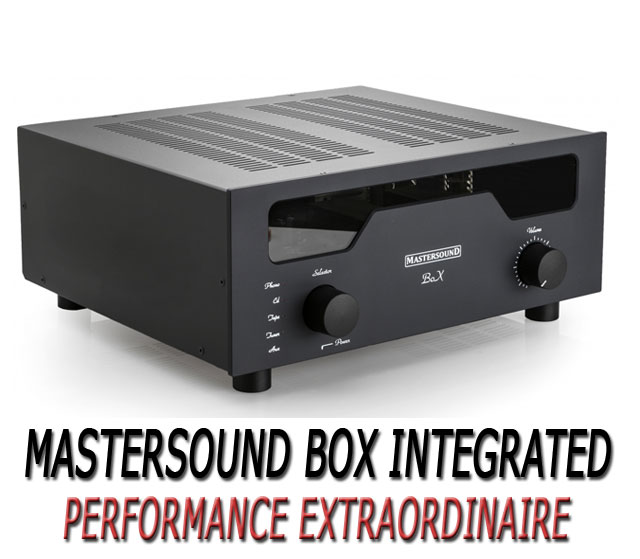

Derek was demoing with the rather unassuming looking vacuum tube based integrated from MastersounD called the BoX Integrated Amplifier ($3,500 with MM phono section, no less), a North Star Design Supremo DSD DAC, the North Star Design Magnifico DSD Transport and a pair of Rosso Fiorentino Certaldo loudspeakers. All are Italian manufacturers. Initially, I thought to myself, “a tube integrated amp led system?” I figured that it would be a nice polite sounding system that would do well in a home office but probably not much more… And then the music started. I was prepared to be polite and make a graceful exit, but truthfully, the music was pretty darn good sounding, compelling even. It was not at all like I had initially expected as I was beginning to become rooted to my chair. I noticed that Derek was using some of the Star Sound Technologies platforms under the equipment in the room and now understood some of why Robert steered me to the room. I have been hearing North Star Design’s offerings at shows for years but always came away thinking that they sound good but seemed like they should sound even better. The same goes for the Rosso Fiorentino speakers. But the sound of this system was lively and dynamic and seemed to handle more of the frequency extremes than it seemed like it could. There was definitely some synergy at work here and I recalled feeling as though this was one of the better sounding rooms I’d visited at this show. But it didn’t take long for me to realize that the MastersounD BoX was the difference maker. My curiosity was so revved up enough that I decided to speak with Derek about the possibility of doing a review. I got in touch with him a month or two later and we worked out an arrangement for a BoX to be delivered for a review.
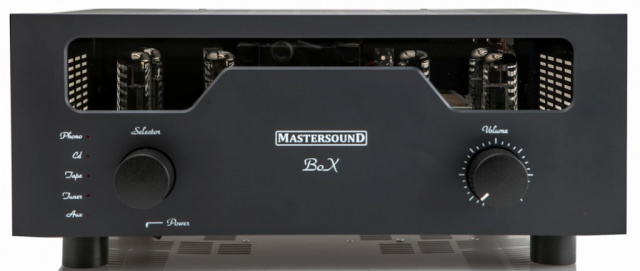
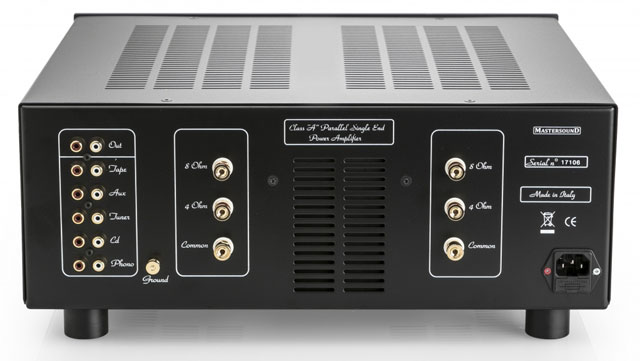
About the BoX
The BoX is a Class-A, single-ended, 35 watts per channel, EL34 based vacuum tube integrated amplifier from Italy. During my discussion with Derek Skipworth about the BoX, there are two things that he felt were very important to convey to the readers of this review. “I think it is important to stress that even at this price point, the amp is still completely designed and built in Italy at MastersounD’s facility,” Derek said. What separates MastersounD from the competition is their in-house transformers. In my opinion, the transformers are what makes a tube amp special and in this case you are getting true world class quality.” The power transformer is made with a high-quality sheet of low loss GO in resin bath (to reduce temperature, vibrations and noise) placed on a support that stabilizes it anti-vibration.”
The BoX is a Class-A design and can get very warm. You would be making a mistake if you judged this piece based on the ascribed 35 watts per channel. With three transformers on the inside, the BoX is a heavyweight at 52 lbs. Moving it around was not all that easy because there are no handles and lifting on one end did not make it seem to be lighter than the other. It’s just heavy, period. The BoX measures 17” D by 16” W by H7” D. Find a place you want to place it, set it down, and don’t think about moving it around anymore. I know I hoped not to have to move it more than I needed to. A peek inside shows that the Box is a very well made, nicely laid out piece of equipment. This quality work is reminiscent of the German-made Audio Valve gear, with their red circuit boards. The BoX’s chassis is finished in a lovely black satin and its build quality is very meticulously done. There are three EL34’s power tubes and one ECC802 S signal tube per channel for a total of eight tubes used in the BoX. The EL34 tubes are auto-biased, which is a feature you would normally find in much more expensive audio gear, ensuring the tubes are always operating at their best. The front panel is made of aluminum with anodic oxidation treatment and has a perforated top plate for plenty of venting at the top. Since the BoX operates in Class A some care and common sense should rule the day when it comes to placement. Suffice to say do not place the BoX and any kind of rack unless you have sufficient room for cooling.
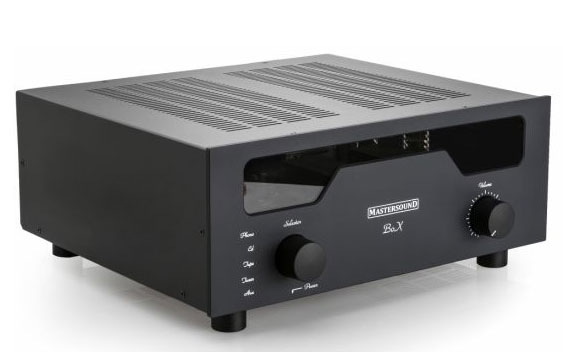
In terms of the external layout, the front plate has a polycarbonate window that allows you to see the internal glow of tubes, which aesthetically, is a very nice touch if you like that kind of thing. The “Mastersound” logo with word BoX finished in white sits in the middle of the faceplate. There are two black knobs, one on either side of the faceplate. The knob on the left is the selector control for the following: Phono, CD, Tape, CD, AUX. There is a small red LED indicator that lets you know which of the inputs has been selected. At the bottom of the selector knob is a little arrow that serves to indicate where the on/off switch is, just underneath the faceplate. The knob on the right side of the faceplate controls the volume level. On the rear panel, which all the connectors are gold plated, to the left, are 6 pairs of single-ended connectors for; Out (for Tape Out), Tape, Aux, Tuner, CD, Phono (MM), with a ground connector next to it. The next two sections are for speaker connectors, for left and right channel, 8 Ohm, 4 Ohm, and Common. Dividing the left and right channel speaker connectors, down the center of the rear panel, are more perforations used for cooling. The IEC connector is on the lower right-hand corner of the rear panel. The BoX does come with a remote control that is annoyingly small. If you put your thumbs side by side, that’s about the same size that the BoX’s remote is. To its credit, the remote is very responsive and I never had an issue with it controlling the volume. Other BoX build features include the chassis being finished in antimagnetic stainless steel. The Box’s nobs are machined from billet aluminum. All of the BoX’s cables inside are copper-silver that are produced in Switzerland. The circuit board is made with copper-coated glass chips.
How It Sounds
I hooked up the BoX, and since it wasn’t brand new, I let it run for just a day before I started to do any serious listening. I was very pleasantly surprised by how musically involving and by how present the musicians sounded. I did not expect this level of performance from a $3500 integrated amplifier. The BoX was playing music that was teeming with natural colors, realistic dynamics and ethereal high-end extension. The BoX paints its sonic pictures with a pallet of warm sounding natural colors. The high-frequency qualities of the BoX’s performance were generally very good, smooth, and never got in the way of my enjoyment. The BoX delivered lower frequencies with good extension, weight and punch. Bass quality of the BoX, overall, is much better than any 35 watt integrated has a right to be. Detail retrieval with the BoX was good and never sounded etched or bright. Imaging with the BoX, in my system, was a bit above average and I address this further on in the review. The BoX allowed the performers within the stage to seemingly sound three dimensional, was solid and alive. Transient response was good with a nice amount of sparkle on cymbals and triangles. I thoroughly enjoyed what the BoX could do with vocals. Vocalists felt eerily “within reach” in my listening room and you could palpably hear every detail of their vocalizations. Whether the singers were breathing into the microphone, turning their head from one side to the other, taking deep breaths, swallowing, whether their tone was deep, raspy or if they were singing in falsetto, they seemed alive in my room.
I was able to find some really great musical references for this review. On Mark O’Connor’s Hot Swing Trio’s CD In Full Swing [Odyssey], the BoX displayed the music with naturalness and realism. Jane Monheit’s vocals on “Honeysuckle Rose” and “Misty” come through as lush and sweet while Wynton Marsalis’ playing with amazing speed and articulation on “Tiger Rag” came across sounding lively, inspired and involving. A live recording that the BoX shined with was
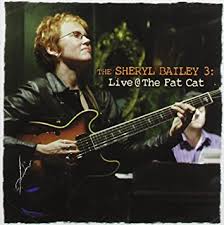
The Sheryl Bailey 3’s CD Live @ The Fat Cat [Pure Music Records]. This recording really benefits from the ambiance and “alive” sounds of a real club and the BoX showed its tube heritage by rendering a greater feeling of “being there” in the club while the performance is taking place. I enjoy listening to Ms. Bailey’s virtuoso guitar work on this disc but on the track “The Wishing Well”, Gary Versace’s work on the Hammond B3 organ is mesmerizing. Another live recording that gave a good example of the BoX’s ability to reproduce a live recording into life-like event in one’s listening room would be Wynton Marsalis’ CD Live at the House of Tribes [Blue Note Records]. Wynton’s brother Delfeayo has produced some of the most compelling live recordings, and in this instance, this CD, recorded by Jeff Jones, is one of the better live recordings I’ve been listening to lately. The BoX did such a wonderful job of conveying the emotion and the energy communicated by Wynton on “You Don’t Know What Love Is” that I kept thinking how I wished I had been there for that performance. Another recording I found audibly fascinating on the BoX was Fritz Reiner and the Chicago Symphony Orchestra’s 1960 performance of Rimsky-Korsakov’s Scheherazade [RCA]. On the BoX, I found that the strength and power of the CSO’s brass section, combined with the naturalness of the strings and woodwind instruments, combined with the frenetic pace at the finish to be both compelling and breath taking.
Final Thoughts
The BoX was very well behaved during its stay in my system. There were no moments of hum, crackling, tube noise or any unexpected hiccups upon turn-on or turn-off. I didn’t get to test out how well the BoX’s MM performance was. My cartridge’s output is too low to go straight into the BoX and the only other piece I could find to try it out with was an old Lehmann’s Cube that I didn’t feel was up to the job. As the BoX only has single-ended inputs I do not have a plethora of single-ended cables to use with the BoX. While the Gabriel Gold, Morrow, and the Clarity Cable did a very good job, things were very nice with the Dynamic Design Lotus and became truly outstanding with the Dynamic Design Titania. The Titania used with the BoX was truly a stunningly good combination either coming off of my Marantz SA-7S1 CD player or my Blue Circle NOS DAC. When describing performance attribute of the BoX in my system you need to take into account that I am using Tekton Design Double Impacts as a reference. These speakers are a 4-ohm load and are 98 dB efficient, well within what would be an easy load for the BoX. Also, any comparison’s I make would be with my VAC Renaissance preamp and VAC Signature iQ and Bully Sound Company mono-amps so, in my opinion, I set a pretty high bar for comparison in most instances. A few things of note regarding the BoX’s performance. With that caveat being said, I did have two areas of performance to comment on regarding the BoX’s melodic performance. The BoX’s imaging capabilities are quite good and I have no complaints there, but being objective, the imaging is not up to the same level as some of the other excellent attributes the BoX exhibits. Imaging is really quite good, just not great. One other note from my objective listening would have to do with the BoX’s performance at low volumes, which in my system, was ordinary at best. This observation would be at lower volumes with the volume knob at around the 9-10 o’clock range. Once you start to get into the 11-12 o’clock range, all that musical specialness becomes quite apparent and very enjoyable. In essence, the music never sounded hard nor could I hear any breakup or negative sonic artifacts all the way down to 4 o’clock on the volume control. That was plenty loud but still clean and under control. Depending upon the impedance and sensitivity of your speakers, your mileage may vary. To be fair; neither of these observations affected my enjoyment of the BoX’s ability to play music and are just points I took note of.
At the end of the day, the MastersounD BoX is a feature-packed integrated amplifier that boasts fabulous build quality, thoughtful design and spendid sonics that well exceeds its $3,500 pricetag. The BoX’s musical performance competes favorably with noteable designs I’ve heard from companies such as Mark Levinson, Pass, T+A, and Jeff Rowland Design Group. The BoX is worthy of being used as the centerpiece in many a high-end system.
There is one other little piece of reviewer investigating I feel compelled to share. I was fortunate enough, the last two weeks I had it, to use the BoX on one of the Star Sound Technologies (SST) platforms, similar to what the BoX was being demoed with at AXPONA. The performance of the BoX on a SST platform takes its performance up at least a notch and helped it compete closely with my VAC/BSC combo. Along with other sonic improvements, the SST also elevated the BoX’s imaging performance to the point where it was as good as anything I had heard in my listening room. The BoX is more than good enough to stand on its own as is, but if you’re able to, save up a little extra so that sometime after you’ve already purchased your BoX, and consider investing in a SST platform. They really are a good match together. But own its own, the BoX is a high-end bargain and a steal at its price. I simply cannot recommend it highly enough.

Specifications:
MastersounD BoX Intgrated Amplifier
Power: 2 x 35 Watt
Tubes complement: 2 x ECC802 – 6 x EL34
Input: 3 line + Phono MM
Load imped.: 4-8 ohm
Bandwidth: 18 hz / 25khz 0 db
Output: 1 line
Output Trasformer: MastersounD
Automatic Bias
Supplied with remote control (optional)
Negative feedback: 0 db
Dimensions: 43,6 x 40,9 x 18,5 cm
Weight: 24 Kg
Price: 3,500 Euro
0 Comments